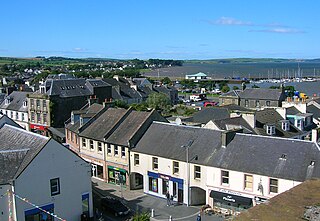
Stranraer is a town in Dumfries and Galloway, Scotland, on Loch Ryan and the northern side of the isthmus joining the Rhins of Galloway to the mainland. Stranraer is Dumfries and Galloway's second-largest town, with a population of nearly 13,000.
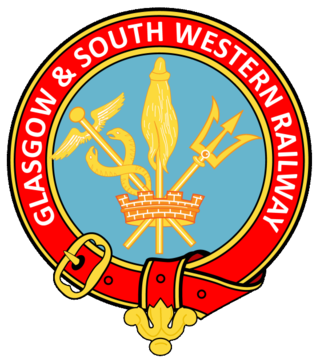
The Glasgow and South Western Railway (G&SWR) was a railway company in Scotland. It served a triangular area of south-west Scotland between Glasgow, Stranraer and Carlisle. It was formed on 28 October 1850 by the merger of two earlier railways, the Glasgow, Paisley, Kilmarnock and Ayr Railway and the Glasgow, Dumfries and Carlisle Railway. Already established in Ayrshire, it consolidated its position there and extended southwards, eventually reaching Stranraer. Its main business was mineral traffic, especially coal, and passengers, but its more southerly territory was very thinly populated and local traffic, passenger and goods, was limited, while operationally parts of its network were difficult.

The Northern Counties Committee (NCC) was a railway that served the north-east of Ireland. It was built to Irish gauge but later acquired a number of 914 mm narrow gauge lines. It had its origins in the Belfast and Ballymena Railway which opened to traffic on 11 April 1848.
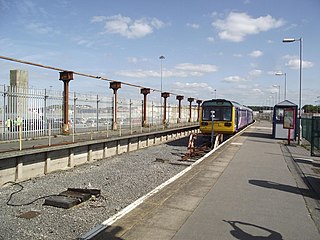
Heysham Port is a railway station on the Morecambe Branch Line, which runs between Lancaster and Heysham Port. The station, situated 7+3⁄4 miles (12 km) west of Lancaster, serves Heysham Port in Lancashire. It is owned by Network Rail and managed by Northern Trains.

Cairnryan is a village in the historical county of Wigtownshire, Dumfries and Galloway, Scotland. It lies on the eastern shore of Loch Ryan, six miles north of Stranraer and 81 miles (130 km) southwest of Glasgow.

Loch Ryan is a Scottish sea loch that acts as an important natural harbour for shipping, providing calm waters for ferries operating between Scotland and Northern Ireland. The town of Stranraer is the largest settlement on its shores, with ferries to and from Northern Ireland operating from Cairnryan further north on the loch.

Belfast Lanyon Place is a railway station serving the city of Belfast in Northern Ireland. Located on Bridge Street in the Laganside area of central Belfast, it is one of four stations in the city centre, the others being Great Victoria Street, City Hospital and Botanic. Lanyon Place is the northern terminus of the cross-border Enterprise service to Dublin Connolly. It is also served by Northern Ireland Railways, which operates routes to other locations in Northern Ireland, including Derry, Bangor, Portadown and Larne.
The Scottish Region (ScR) was one of the six regions created on British Railways (BR) and consisted of ex-London, Midland and Scottish Railway (LMS) and ex-London and North Eastern Railway (LNER) lines in Scotland. It existed from the creation of BR in 1948, and was renamed to ScotRail in the mid-1980s.

Paisley Gilmour Street railway station is the largest of the four stations serving the town of Paisley, Renfrewshire, Scotland, and acts as the town's principal railway station. The station is managed by ScotRail and serves the Ayrshire Coast Line and Inverclyde Line, 7+1⁄4 miles (11.7 km) west of Glasgow Central. The station is protected as a category B listed building.
The Portpatrick and Wigtownshire Joint Railways was a network of railway lines serving sparsely populated areas of south-west Scotland. The title appeared in 1885 when the previously independent Portpatrick Railway (PPR) and Wigtownshire Railway (WR) companies were amalgamated by Act of Parliament into a new company jointly owned by the Caledonian Railway, Glasgow & South Western Railway, Midland Railway and the London & North Western Railway and managed by a committee called the Portpatrick and Wigtownshire Joint Committee.
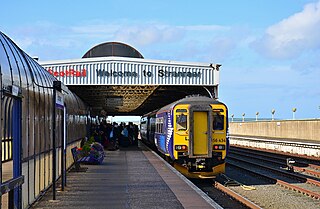
Stranraer railway station is a railway station that serves the town of Stranraer, Dumfries and Galloway, Scotland. The station is 94.5 miles (151 km) southwest of Glasgow and is the terminus of the Glasgow South Western Line. It has two platforms and is staffed on a part-time basis. Stranraer station remains owned by Stena Line and not Network Rail

The Glasgow South Western Line is a mainline railway in Scotland that runs from Glasgow to Kilmarnock, and then either Carlisle via Dumfries, or Stranraer via Ayr, with a branch to East Kilbride.

Dumfries railway station serves the town of Dumfries in Dumfries and Galloway, Scotland. It is located on the Glasgow South Western Line. The station is owned by Network Rail and managed by ScotRail who provide all passenger train services. It is staffed on a part-time basis throughout the week.
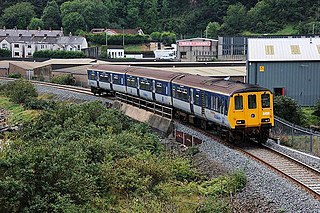
The Belfast–Larne line, or Larne line, is a railway line in Northern Ireland, operated by Northern Ireland Railways. It runs as double track along the majority of its route north along the scenic east Antrim coastline from Belfast to the coastal seaport town of Larne, serving commuters and ferry passengers.
The Maidens and Dunure Light Railway was a railway in Ayrshire, Scotland built to open up coastal communities by connecting them to the main line railway network.
The Ayr and Dalmellington Railway was a railway company in Scotland, which connected the growing ironworks community around Dalmellington with Ayr, in Ayrshire, Scotland. Its route was originally planned by the Ayrshire and Galloway Railway as part of a scheme to link Ayr with Castle Douglas, but lack of funds limited the construction to a very short section connecting the iron and coal pits of the Dalmellington Iron Company with its iron works, opening in 1849.
The Ayr and Maybole Junction Railway (A&MJR) was a railway in Ayrshire, Scotland that provided services between Ayr and Maybole. It opened in 1856 and was seen as a link in providing a through line between Glasgow and Portpatrick, then the ferry port for the north of Ireland.
The Maybole and Girvan Junction Railway was a railway company that constructed a line between Maybole and Girvan. Although promoted independently, it was supported by the Glasgow and South Western Railway, and was seen as part of a trunk line connecting Glasgow with a ferry port for the north of Ireland.
Girvan and Portpatrick Junction Railway (G&PJR) was a railway company in Scotland. It opened in 1877 between Girvan and Challoch Junction, where it joined the Portpatrick Railway, which had already reached Stranraer from Castle Douglas. Portpatrick had been an important ferry terminal for traffic to and from the north of Ireland, but its significance was waning and Stranraer assumed greater importance. The new line formed part of a route between Glasgow, Ayr and Stranraer.
The Dumfries, Lochmaben and Lockerbie Railway was a railway in Dumfriesshire, Scotland. It connected Dumfries with Lockerbie via Lochmaben. Promoted independently, it was absorbed by the Caledonian Railway to give access to Dumfriesshire and later to Portpatrick for the Irish ferry service. It opened in 1863, closed to ordinary passenger services in 1952, and closed completely in 1966.













